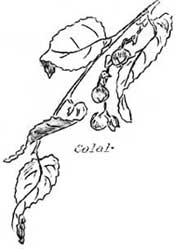
 | ||||||||

With the closing of the summer's brilliant floral display comes a period, equally interesting from a botanical viewpoint - particularly at the lower elevations on "The Mountain". When the fruits of our plants ripen we cannot help but become aware of the beauty of many of them. And though the fruiting stage of our plants is past at this time it deserves some mention - even though it may be a tardy one. In the alpine meadows one sees on every hand the fruit of the
Western Anemone - that shaggy, grey "feather duster" cluster of seeds,
each possessed on a long silky thread which serves as a sail by which
the late fall winds carry them about to places where new plants of
the Western Anemone are destined to grow. This is not the only plant
whose seeds carry "parachutes", as you probably know. The dandelion
(yes we have several species of that plant even here), aster,
dogbanes, hawkweed and yarrow, are others whose seeds are disseminated
in that manner.
In the lower densely forested slopes one finds areas in the shade of the great trees thickly covered with masses of Wood Sorrel. It is beautiful in the spring with its light green, clover-like foliage and delicate flowers. But in the fall, upon maturity of its fruit it is even more interesting. For this plant employs a method of seed dissemination that is very distinctive. The seeds are shot with such force from the fruits that they come to rest at a considerable distance from the parent plant. Many of the most beautiful fruits are found on plants of the Lily Family. As one threads his way along the wooded trails of the lower elevations he will rarely fail to notice the attractive decoration possessed by the Queen's Cup or Alpine Beauty. In the spring its single white flower is beautiful but fall finds this plant adorned by a fleshy berry of delicate turquoise which, like the flower, is held aloft upon its slender stem. Fairy Bells - also a plant of the shaded woods and a member of the Lily Family - will likewise be found to be of interest. Like the flowers, the fruit, a red berry, will be found to be hidden from the eye of the casual hiker by the leaves. We must look carefully,then, to see these striking, brilliant fruits of this plant. Other plants of the Lily Family have fruits equally as beautiful and striking.
The Oregon Grape indicates the reason for its common name in the fall. For, in the place of the yellow flowers, we then find numerous bluish berries, like small grapes. And, it is said, that delicious jelly can be made from this fruit though it may be exhausting for one to gather enough of this fruit for that purpose. The Salal, one of the best known wild plants of this region, also has a conspicuous fruit - a large, deep blue-black berry which the Indians of this region used to some extent as food in years gone by. Of course everyone knows the Huckleberry. Its lucious fruit has contributed many a delicious bit to the meals of American homes. And what small boy has not "wallowed" in the juicy flower of these berries? Yet, you and I aren't the only seekers of the huckleberry here on "The Mountain" - bruin's sweet tooth must also be satisfied and so in the fall we find many bears competing with us in the gathering of this wild fruit. Nor must we forget the Canadian Dogwood whose cluster of brilliant red berries adds a touch of color to the shaded depths of the forest in later summer and early fall. Often it blooms and bears seeds twice in one season so that we have a double opportunity to enjoy its beauty, both of flower and seed. Yes, the fruits of our plants are very worthy of note! (C.F.B.) | ||||||
| <<< Previous | > Cover < | Next >>> |
vol10-11b.htm
17-Nov-2001